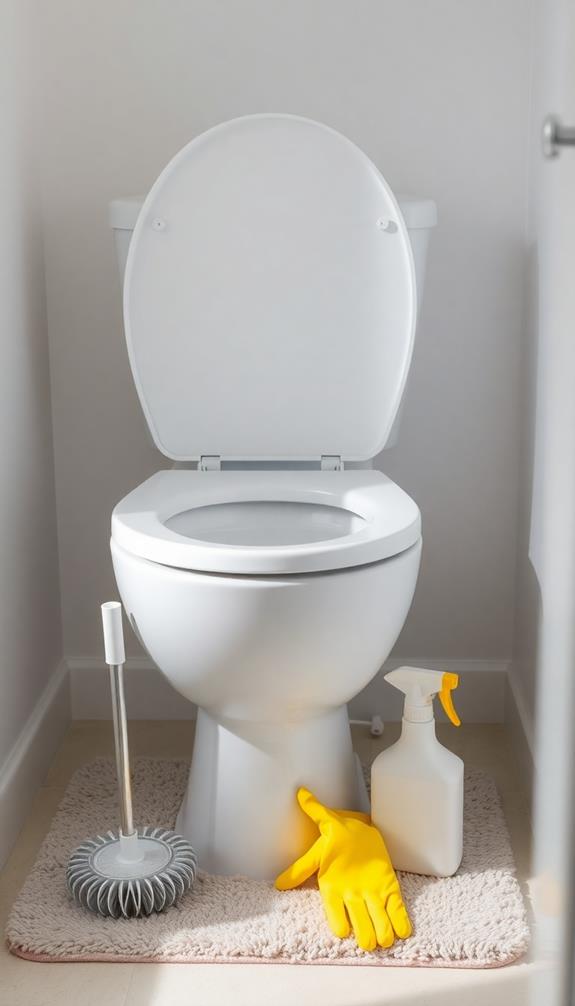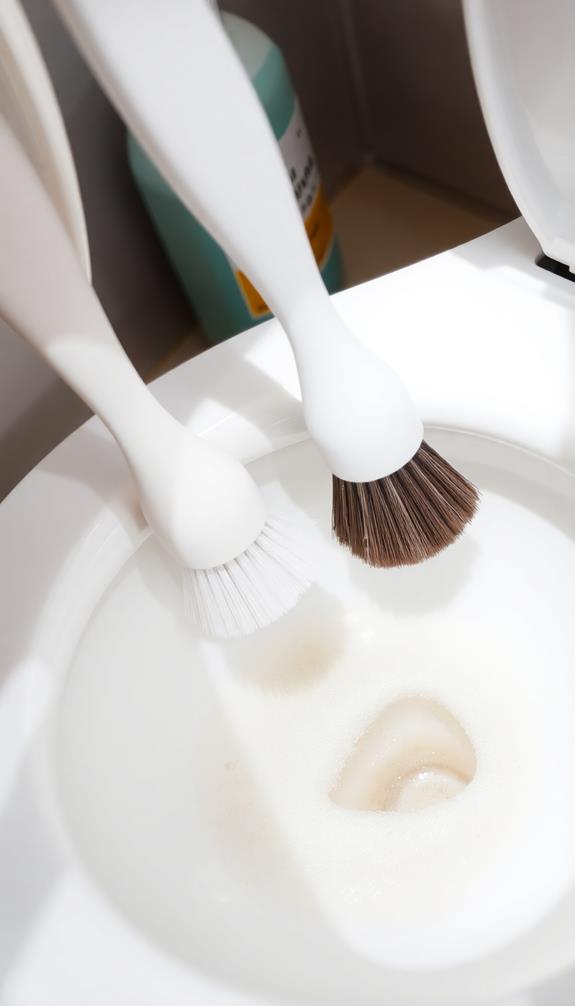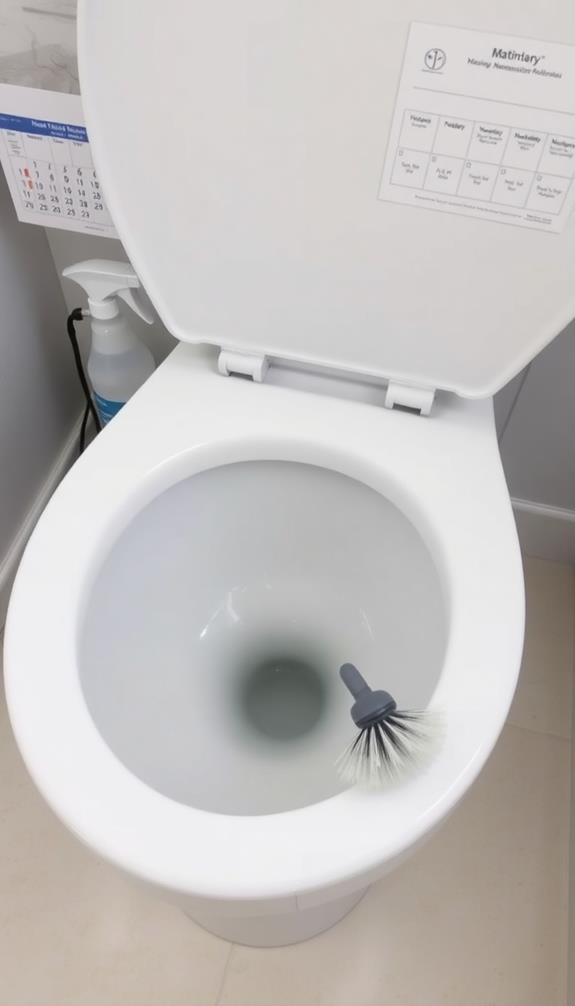Cleaning the toilet ring is easy and can be done in just seven steps. First, gather your supplies: a sturdy toilet brush, vinegar, baking soda, and rubber gloves. Pour a cup of vinegar into the bowl, followed by a few drops of essential oils, and then add half a cup of baking soda. Let it fizz for a moment before scrubbing the stains with your brush. Flush to rinse away debris and cleaning agents. Regularly swish your toilet to prevent buildup. Follow these steps, and you'll keep your toilet fresh and clean. Stick around for tips on effective maintenance and more.
Understanding Toilet Bowl Rings
Have you ever wondered what causes those pesky toilet bowl rings? These unsightly stains are primarily the result of mineral deposits from hard water, which contains high levels of calcium, iron, and magnesium. Over time, these minerals accumulate around the water line, forming those annoying rings you see.
Regular cleaning with toilet bowl cleaner can notably reduce the buildup of these deposits. The color of these stains can tell you a lot; brown or green rings usually indicate mineral buildup, while pink or light orange stains are often caused by Serratia marcescens bacteria thriving in stagnant water.
Factors like poor ventilation and high humidity can worsen the problem, promoting bacterial growth and mold. Frequent flushing and low water levels can also contribute to the issue, as they allow minerals to settle more easily.
To combat toilet bowl rings, understanding their causes is essential for effective prevention. By incorporating a consistent cleaning routine, you can minimize the buildup of mineral deposits and bacteria. Regularly scrubbing the toilet bowl and ensuring proper water levels can help maintain a cleaner toilet, reducing the appearance of those pesky stains.
Now that you know what causes toilet bowl rings, you're better equipped to keep your toilet sparkling clean!
Essential Cleaning Supplies
To effectively tackle toilet bowl rings, you'll need a few essential cleaning supplies that make the process easier and more efficient. First, grab a sturdy toilet brush with stiff bristles; it'll help you scrub away those stubborn stains effectively.
You might also want a pumice stone for tougher marks, as it can tackle stains without scratching the porcelain surface. Utilizing non-toxic cleaning solutions like distilled white vinegar and baking soda is a great way to guarantee your cleaning process is safe for both your family and the environment. These natural cleaning agents create a fizzy reaction that loosens stains and mineral deposits, making your job easier.
If you're dealing with particularly persistent stains, consider using commercial products like Bar Keepers Friend, which are readily available in grocery stores and designed for tough cleaning tasks.
To protect your hands during the cleaning process, rubber gloves are a must, especially when handling strong chemicals or scrubbing agents.
Step 1: Prepare the Bowl

To start, gather your cleaning supplies, like a sturdy toilet brush and your preferred cleaning agents.
Proper tools are essential for effective cleaning.
Next, take a moment to inspect the bowl for any visible stains and rings, as this will help you choose the right cleaning method.
Gather Cleaning Supplies
Before diving into cleaning, what supplies do you need to tackle that stubborn toilet ring? Start by gathering essential cleaning supplies.
You'll need a sturdy toilet brush, which is vital for scrubbing away those pesky stains. Don't forget a pair of rubber gloves to protect your hands and maintain hygiene during the process.
Next, grab some baking soda and distilled white vinegar. These two natural cleaning agents work wonders together and can effectively break down stains.
If you encounter tougher rings, a pumice stone is a great addition; it's safe for porcelain and can provide that extra abrasive action without scratching.
A spray bottle for the distilled white vinegar will come in handy, allowing you to apply it directly to the affected areas for better coverage.
Finally, prepare to use any cleaning solution you choose by letting it sit for a few minutes after application. This time will maximize its stain-fighting potential before you start to scrub.
With these supplies on hand, you're all set to make your toilet shine!
Inspect for Stains
When you're ready to tackle that toilet ring, start by inspecting the bowl for any visible stains or discoloration.
Take a good look at the inside of the toilet bowl, as the color and type of stains can indicate their source. For example, hard water deposits often leave a white or chalky residue, while darker stains may suggest bacterial growth. If needed, grab a flashlight to check beneath the water line, where stains can be more pronounced.
Don't forget to flush the toilet before you begin your inspection. This will remove any loose debris and give you a clearer view of the toilet bowl's interior.
While you're at it, take note of any lingering odors, which could signal mold or bacteria contributing to the staining issue.
As you inspect, assess how severe the stains are, as this will help you choose the right cleaning product later on.
If you find that the water level is low, consider adjusting it, since low water levels can lead to increased staining and make it harder to clean effectively.
Check Water Levels
Maintaining the right water level in your toilet bowl is essential for effective cleaning and maintenance. First, check water levels to confirm that the bowl has a sufficient water level. If it's too low, you risk increased mineral buildup and stubborn toilet bowl rings. A proper water level helps prevent stagnation, which contributes to these unsightly stains.
To adjust the water level, inspect the float mechanism in the tank. If it's set too low, adjust it to allow more water to fill the bowl during flushing. This simple tweak can make a significant difference in keeping your toilet clean.
You can also use a ruler or measuring tape to check the water level against the manufacturer's recommendations for peak performance.
Regularly inspect and maintain your toilet's water supply to maintain consistent water levels. This not only aids in cleaning but also helps prevent future stains, making your cleaning routine much easier.
Step 2: Apply Cleaning Solution
Now that you've prepped the toilet, it's time to apply a cleaning solution that tackles those stubborn rings. Start by pouring one cup of distilled white vinegar into the toilet bowl. This will help break down mineral deposits and stains.
For an even greener approach, consider adding a few drops of essential oils for their antibacterial properties natural cleaning agents. Next, add half a cup of baking soda to the vinegar. You'll notice a fizzy reaction, which effectively loosens those tough stains.
If you're dealing with particularly stubborn stains, sprinkle a generous amount of Borax into the bowl. Let it sit for about 20 minutes to allow the solution to work its magic.
Alternatively, if you prefer a commercial cleaner, products like Bar Keepers Friend or The Pink Stuff can be effective. Just apply them to a wet sponge and let them sit for 20 minutes to maximize their cleaning capabilities.
For a natural approach, consider sprinkling lemon juice or citric acid around the stains. Their acidic properties can help dissolve the buildup without harsh chemicals.
Whichever method you choose, make sure the cleaning solution has enough time to penetrate the stains before moving on to the scrubbing step.
Step 3: Scrub the Stains

To effectively tackle those stubborn stains, grab a silicone toilet brush and start scrubbing the toilet ring. This flexible brush is perfect for accessing the curved surfaces without scratching the porcelain.
First, apply your cleaning agent—preferably a mixture of vinegar and baking soda—to the stains. Alternatively, consider using eco-friendly disinfectants like Seventh Generation for a safer cleaning solution. Let it sit for about five minutes. This will enhance its cleaning power.
Once the time is up, focus on scrubbing in circular motions around the ring. This technique helps lift and remove mineral deposits and bacteria build-up. If the stains are particularly tough, consider using a wet pumice stone. Just make sure it's damp to avoid scratching the toilet bowl.
After your initial scrubbing, take a moment to inspect the toilet for any remaining spots. If you spot stubborn rings that just won't budge, don't hesitate to repeat the process.
A thorough scrub can make all the difference in achieving a clean and sparkling toilet. By following these steps, you'll guarantee your toilet stays fresh and hygienic, free from unsightly stains. Happy cleaning!
Step 4: Flush and Rinse
After giving the toilet ring a thorough scrub, it's time to flush and rinse the bowl.
Start by flushing the toilet to effectively wash away any loosened debris and cleaning agents. This step guarantees a thorough clean and helps rinse away any remaining cleaning solution, preventing potential buildup from residue.
If you notice that stains are still visible, don't hesitate to flush multiple times for ideal results, especially if you used thicker cleaning agents.
Regular flushing after cleaning is essential for maintaining hygiene and preventing the reformation of toilet rings in the future. It not only clears the toilet bowl but also helps keep it fresh and clean.
After flushing, take a moment to verify that the toilet is functioning properly. Any issues with flushing may indicate a need for maintenance, which can prevent lingering stains and keep your toilet in prime shape.
Step 5: Regular Maintenance Tips

Keeping your toilet clean and free of unsightly rings requires consistent maintenance. Start by swishing the toilet bowl daily with a toilet brush. This simple action helps prevent the buildup of stains and keeps your toilet clean.
Additionally, consider using a DIY natural cleaner for your toilet that utilizes eco-friendly ingredients, providing effective results without harsh chemicals. Deep clean your toilet at least once a week using a disinfectant to eliminate bacteria and odors.
To make your cleaning routine easier, keep a cleaning supply caddy in the bathroom. With all your toilet cleaning supplies organized and within reach, you'll be more likely to perform quick touch-ups as needed.
Additionally, consider using toilet tank cleaners that release cleaning agents with each flush. These products help minimize stains and buildup, making your weekly cleaning easier.
Don't forget to inspect for leaks regularly. Leaks can lead to prolonged water stagnation, increasing the likelihood of toilet ring formation.
Conclusion
Keeping your toilet bowl clean doesn't have to be a chore. Did you know that a staggering 50% of households have toilet bowl rings at any given time? By following these seven easy steps, you can banish those pesky stains and maintain a fresh bathroom. Regular upkeep not only makes your toilet look great but also helps prevent larger cleaning jobs down the line. So, grab your supplies and tackle that toilet ring—you've got this!